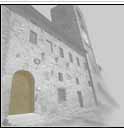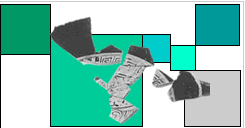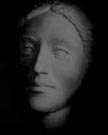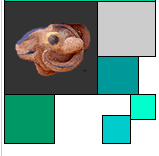



The Girl of Porciglia |
|
| The reconstruction of the face | |
 |
The
reconstruction of the features of the owner of the earrings, undertaken
at the instigation of the Colle Val D’Elsa Archeological
Group, came about thanks to two groups of anthropolgists: the
group under Elsa Pacciani at the Restoration Unit at the Tuscany
Superintendency for Archeological Assets and the group under Prof
Francesco Mallegni at the University of Pisa, adopting the methods
refined by forensic scientists in the US, who have to put a face
to people who have been killed, and whose skull has been found.
After taking a plaster cast of the skull so as not to use the
original (figs 1 and 2), some pegs were inserted on it at certain
points of the face and the cranium. The exact relative positions
of these are in proportion to the density of tissue in an individual
of medium build. The pegs were joined together by small strips
of plasticine (figure 3), and the spaces formed thereby were filled
with more plasticine (fig 4). Subsequently, the face, the mouth,
and the eyes were modelled, as well as the hair, taking into account
her gender, her age at death, and her ethnic group, and consulting
artistic reproductions from the time. The physiognomy has a 90
per cent probability of corresponding to the features of the girl
while alive. |
| The site | |
In
1996, an excavation by the Colle Val D’Elsa Archeological
Group led to the identification of an Etruscan burial area at
‘Le Porciglia’, between the ‘Le Ville’
necropolis and the Archaic Etruscan settlement of ‘Poggio
di Caio’. It was probably an underground tomb datable to
the 6th century BC, of which the only evident remains were two
graves separated by a partition, below burial platforms. It contained
skeletal remains belonging to eight individuals buried by inhumation,
most of the bones being in their original position. The fact they
appear in pairs suggests that there was a close kin relationship
between them. |
|
| The material | |
|
The
scant material found includes: a jar with three handles near the
top, with painted geometric decorations in bands, reminiscent
of models from southern Etruria; a lid with applied decoration
which probably belonged to the same jar; fragments of a small
jar made of grey bucchero; a spindle-whorl; an iron brooch; bronze
material; and a splendid pair of gold ‘casket’ earrings
found still ‘in situ’ on the skeleton of their owner
(n. 1). The right-hand earring retained its original position
with regard to the cranium owing to the rotation of the head to
the right, which occurred before decomposition, and to a process
of calcareous cementation as a result of water filtering into
the tomb. During restoration, it was decided to maintain this
connection, keeping a small column of earth holding it in place. |
|

